Audi A6 Typ 4G: Tire Damage
General Information
 Note
Note
Because tire damage can have serious consequences, the technician and the driver should regularly check the tires, as it is the best form of early problem recognition.
Pre-damaged tires cannot withstand driving situations like high vehicle speed, long driving distance, sporty driving style and similar situations.
Damage can occur from various causes:
- Driving with low tire pressure
- Mistakes during tire mounting
- Damage during run-in
- Aging
- Incorrect storage
 Caution
Caution
As soon as a safety risk cannot be ruled out, the tire must be replaced.
Tires, Examining
Pay special attention to the following criteria when examining the tire:
- Surface erosion or marbling on the inner side (pressure was too low or insufficient for the load).
- Detached rubber or loose cords.

- Exposed or deformed bead bundle.

- Damage to tire bead with visible cords.
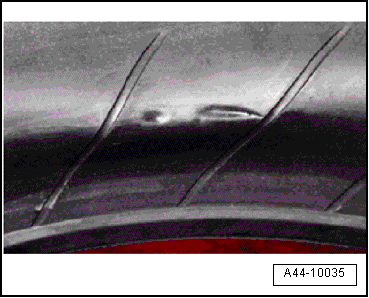
Radial Tires, Construction
The illustration shows a cross section of a radial tire.
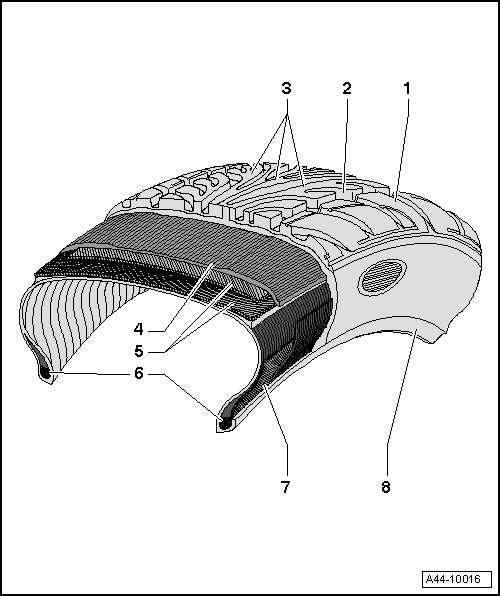
1 - Tread Block
2 - Tread Groove
3 - Tread
4 - Nylon Ply
5 - Radial Tires, Mostly Consist of Steel
6 - Bead Bundle
- Consists of steel wires vulcanized into rubber make sure that secure seating of the tire on the rim
7 - Bead Filler
8 - Wheel Flange Protection
- Protects the rim and tire from abrasion due to, for example, contact with the curb. Wheels with rim protection are identified with the abbreviation MFS
The nylon ply -4-, belt layers -5-, bead bundle -6- and bead filler -7- form the shell. The shell is the load-bearing structure of the tire.
Disintegrated Tread

Cracking
Cracking is the term for shallow cracks in the sidewall of the tire.
They run starting from the bulge in the direction of the tire shoulder.
The cause is the increase in material at the joints of the tire components.
Cracking has no effect on:
- Safety
- Service life
- Driving behavior or other tire characteristics
Cracks can be of varying visibility. Removing the tire from the rim or an examination is not necessary.
How did the cracks form?
Modern steel belted tires are constructed with single-ply sidewalls to save weight.
The sidewall components consist of long strips before they are joined together to form a tire. They must overlap at the joints. Small irregularities/ripples form in the area of the overlapping components. The overlaps are easier to see from the outside due to the single-ply construction.
Impact Damage
A swelling in the flank of the tire indicates that the substructure of the shell has been damaged.
Typical causes for such damage include, for example, driving over curbs at a sharp angle.
Pinching the shell of a tire this way can damage the shell.
The substructure of the tire is stretched so far that individual fibers in the shell may break.
The extent of the damage depends on the speed of impact, the angle of impact, the air pressure, the axle load and the type of obstacle.
Evidence of pinching in the tire side wall.
 Note
Note
- Driving over curbs must be avoided!
- When it cannot be avoided, curbs should be driven over very slowly at the bluntest possible angle.
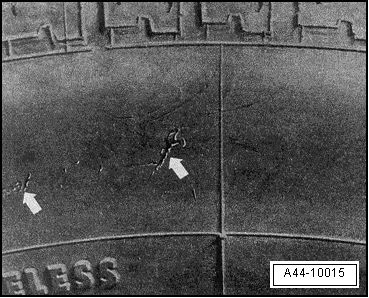
Interior view of a tire with a punctured shell.
Due to a severe impact, the shell was pinched on the rim flange and is ruptured in the contact patch.
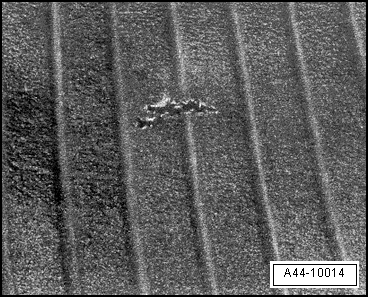
Double rupture caused by pinching when driving over a curb. Often not detectable from outside.
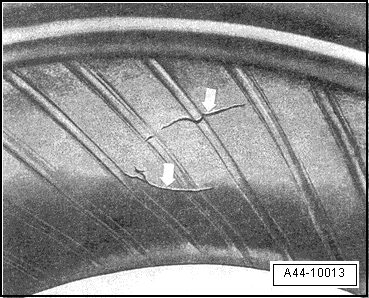
Cuts
Cuts caused by a sharp-edged obstacle.
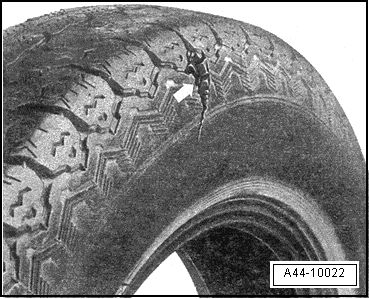
Damage from Foreign Debris
Driving over hard, pointed objects like nails, screws and the like can pierce the tire.
This always leads to tire damage.
Frequently, the foreign object is so securely embedded in the tire that it will not free itself even at higher speeds. Due to this, it can act as a plug and seal the tire relatively well. The result is gradual loss of pressure which the driver does not notice immediately but which can lead to sudden and complete tire failure.
Tires, Air Loss
If the customer complains of loss of air from a tire, the tire must absolutely be checked for embedded foreign debris.
 Note
Note
No repair should be attempted on steel belted tires of which the structure has been punctured by a foreign body.
Corrosion can develop on the steel wires. This will always lead to the separation of the rubber from the steel belt.
Generally, it cannot be determined when the foreign debris was embedded. Therefore, the tire structure may already have been damaged due to driving with insufficient tire pressure.
Damaged belt wires will lead to separation of the rubber from the steel belt sooner or later. As a result, the tire can fail completely after a certain running time, long after the tire damage has occurred.
Tire damage caused by foreign debris is not covered by warranty.
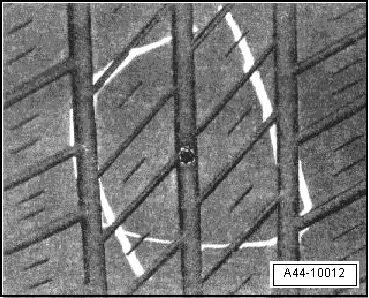
Mounting Damage
Bundle broken during tire inflation.
Modern radial car tires are mounted only on safety rims. These have a hump -1- running along the shoulders.
1 - Hump (H2)
2 - Inner bead seat
3 - Rim
4 - Wheel disc
5 - Outer bead seat
The hump prevents the tire from being pressed out of the bead seat during travel with insufficient tire pressure.
When the tire is inflated, the tire bead may not slip completely over the outer rim hump.
In this case, there is the danger that the bead bundle will be overstretched if the tire pressure is too high and the steel wires rupture partially or completely. Torn bundles are often not detectable from outside.
 DANGER!
DANGER!
- Tires with damaged bead bundles are not seated safely and securely on the rim. Such tires are a safety risk!
- In addition, there is the danger that a partially broken bundle tears during continued operation and the tire suddenly tears open. If the bead bundle breaks during inflation, the shell will also be destroyed.

Bead Damage Caused by Tire Changers
The following mistakes when fitting tires can lead to severe tire damage.
- When rolling in the upper bead on the tire changer, the opposing tire bead does not lie completely in its bed.
- The mounting head was adjusted incorrectly.
- The edge of the fitting roller rolls onto the bead.
- The guide rollers are worn or have sharp edges.
Frequently, mounting and run out marks from the guide rollers are identified in the damaged area.
 Note
Note
Both tire beads as well as the bead seats must always be coated with fitting paste.
If mounting damage is undetected, there is the danger that the tire will fail later when driving.
THEREFORE!
- Never fit a tire without fitting paste.
- Do not inflate the bead seating pressure above 3 bar (43.5 psi).
- Do not inflate the tire filling pressure above 4 bar (58 psi).
- After the tire has been fitted, reduce the air pressure to the specified value.
Tire Pressure
Air pressure must be checked regularly. It is recommended to check the tire pressure every 14 days. The correct tire pressure is especially important during long trips or if a load must be carried. A sporty driving style also requires correct or even slightly increased air pressure.
Tires, Damage from Low Tire Pressure
The most common causes of failure are small external damage, a defective valve or a leaky rim due to corrosion or damage.
Strong heating due to driving with substantially low pressure leads to overheating and subsequent separation of shell from rubber.
The tire shown here was sporadically driven with tire pressure insufficient for the load. Typical indications for this are the circumferential abrasions in the area of the bead caused by the rim flange and the discoloration. Small, furrowed folds are visible along the inner sidewall.
When the tire rolls, strong shear forces develop between the steel belt layers, especially at the ends of the belts.
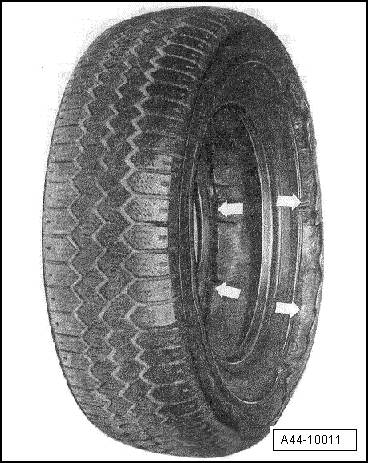
Wide furrows along the circumference in the area of the bead indicate that the tire was driven with insufficient air pressure.
Driving a vehicle with insufficient tire pressure or ignoring or not recognizing tire damage can have serious consequences.
The tire can no longer withstand the forces developing during travel.
The function of the tire is limited by the defects mentioned above. The rubber compounds separate from one another, resulting in partial separation of tire components up to complete destruction.
Such damage usually develops over a longer period of time. If an already damaged tire is exposed to high stress, the centrifugal force at higher speeds can tear components off the tire.
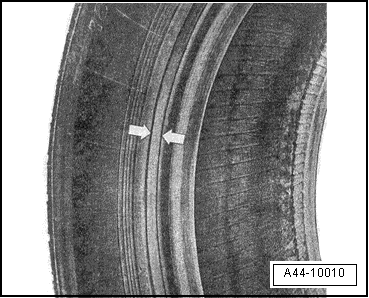
Slow Loss of Air Pressure
The slow loss of tire pressure is an especially tricky process because even experienced drivers often do not notice it.
The insufficient air pressure and the related increase in force required to flex the tire (inner friction) cause the tire material to heat up so much that the various components and rubber compounds can separate.
The final stage is usually the complete destruction of the tire.
The cause for the slow pressure loss cannot always be determined because the tire is severely damaged and components of the tire are missing.
The following pages show tires that were destroyed by driving with low tire pressure.
Tire Temperature, Rising When Tires Pressure Is Too Low
The diagram shows the temperature behavior of a tire at 180 km/h (112 mph).
A - Normal range. When maintaining the specified tire pressure, the temperature remains stable
B - Danger zone. When the air pressure is 0.3 bar (4.35 psi) below specification, the temperature rises to above 120º C (32º F) at higher speeds
C - Critical temperature limit. The tire defect is triggered
T - Temperature
- Driving time in minutes
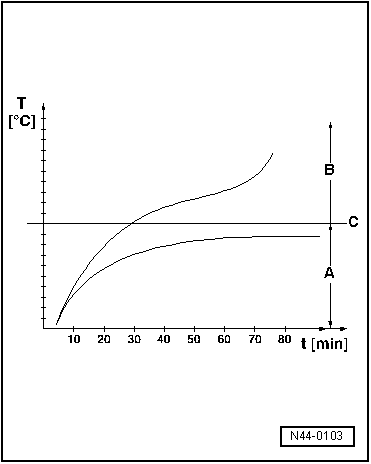
Cracked Tires
Applies to cracks on tires or tread blowouts and tire breaks.
It is not possible to bill for damage to external effects.

